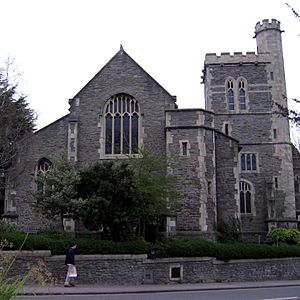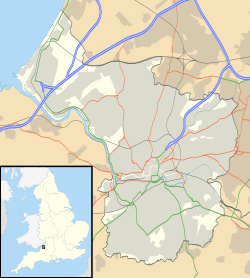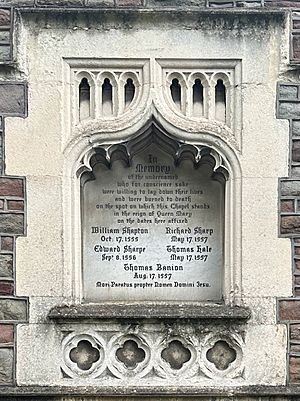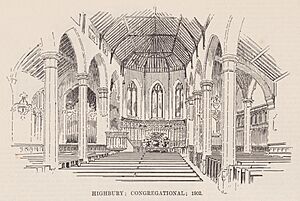Cotham Church facts for kids
Quick facts for kids Cotham Parish Church |
|
|---|---|
| Church of St Saviour with St Mary, Cotham | |
 |
|
| 51°27′45″N 2°36′01″W / 51.4625°N 2.6002°W | |
| OS grid reference | ST584739 |
| Location | Cotham Road, Cotham, Bristol, |
| Country | England |
| Denomination | Church of England |
| Previous denomination | Congregational |
| Churchmanship | Liberal Catholic |
| History | |
| Status | Active |
| Architecture | |
| Functional status | Parish church |
| Architect(s) | William Butterfield |
| Style | Gothic Revival |
| Years built | 1842–1843 |
| Administration | |
| Parish | Cotham St Saviour with St Mary |
| Archdeaconry | Archdeaconry of Bristol |
| Diocese | Diocese of Bristol |
Cotham Church is a beautiful building in Cotham, Bristol, England. It was built in a style called Gothic Revival, which means it looks like old medieval churches. Since 1975, it has been a Church of England parish church. Today, it is known as the Church of St Saviour with St Mary or simply Cotham Parish Church.
Contents
History of Cotham Church
Highbury Chapel: The Beginning
Cotham Church was first known as Highbury Congregational Chapel. It was built in 1842 and opened on July 6, 1843. The land for the chapel was given by Richard Ash.
The architect who designed the chapel was William Butterfield. This was his very first big project! He got the job because his family knew William Day Wills, who was part of the famous W. D. & H. O. Wills tobacco company. Henry Overton Wills II, another important person from the Wills family, was a main leader of the chapel in the mid-1800s.
The chapel's location was chosen partly because of its connection to historical events. There is a memorial on the outside north wall of the church, and another inside, for people who were remembered there.
The Chapel's Location
The area where the chapel was built was once known as 'Gallows Field'. This was a historical site. The original gallows were moved in 1820. A stone from an old cross, called Bewell's Cross, is now part of the church's boundary wall. There is a plaque above it.
The name 'Highbury Chapel' was chosen to honor Highbury College in London. This college was a very important school for nonconformist religious studies at that time. The chapel's first minister even studied there. The name 'Highbury' became popular in the area. Many local places, like Highbury Villas and Highbury Parade, still use this name today.
Growth and Changes
The chapel opened for worship in July 1843. It started with a small group of twenty-one people. In July 1844, the Reverend David Thomas became the minister. He stayed until 1875. He was a very well-known speaker and even became the Chairman of the Congregational Union of England and Wales in 1865.
The chapel grew a lot during this time. This was partly because of Rev. Thomas's reputation and partly because the area around the church was developing. New parts were added to the chapel in 1863 by Edward William Godwin. These included the apse, tower, transepts, and vestries. A school with a lecture room and three classrooms was also added. These changes made the chapel big enough to seat 700 people!
When Rev. David Thomas passed away in 1875, his son, Arnold Thomas, became the new minister. Arnold Thomas was also very respected. Like his father, he served as Chairman of the Congregational Union of England and Wales. He was even offered a teaching job at Mansfield College, which was Oxford University's first nonconformist college. Arnold Thomas had good relationships with leaders of the Church of England. In 1918, they invited him to lead prayers at Bristol Cathedral to celebrate the end of World War I.
Cotham Church as an Anglican Church
In 1972, the Congregational Union of England and Wales changed. Some parts joined the United Reformed Church, while others formed new groups. In 1975, the Church of England bought Highbury Chapel. They changed it into an Anglican church.
Today, it is known as the Church of St Saviour with St Mary, or Cotham Parish Church. It is part of the Diocese of Bristol. The church is considered a Grade II* listed building by English Heritage. This means it is a very important historical building.
See also
- Churches in Bristol
- Grade II* listed buildings in Bristol




